The charming and cobbled Old World cornucopia of medieval Óbidos Portugal is just an hour north of Lisbon. The dreamy UNESCO village is perched fetchingly on a hill and encircled with stout medieval walls.
It’s decorated with splashes of ultramarine and saffron yellow paint and filled with bougainvilla-covered whitewashed homes a cherry pots of geraniums.
You’ll be seduced by its beauty and shabby chic romantic aura.
I arrived via car on a cloudy day in late April. After Lisbon’s hustle and bustle, Óbidos seemed laid back and bucolic.
The clouds didn’t deter me one bit. I was entranced, basking in the brisk springtime air and the honeysuckle breeze.
Here’s my guide to amazing things to do in Óbidos.
>>> Click here to book a guided walking tour
Mini History of Óbidos
The word Óbidos derives from the Latin term oppidum, which means citadel or fortified city. If you want to see a really ancient oppidum, visit Citânia de Briteiros in northern Portugal outside Porto.
The Visigoths founded Óbidos in the 7th century. After the fall of the Roman Empire, the Moors occupied the town and built Óbidos Castle. The Christians reconquered the town in the 12th century.
Under Portuguese rule, and due to its strategic location along the Atlantic Ocean, Óbidos flourished into a major trading port.
Beginning in 1282, each king of Portugal gave the town of Óbidos as a wedding present to his future queen.
King Dinis began the tradition. When he showed his future wife Dona Isabel the lovely town, she fell instantly in love — a common enough spell for those visiting Óbidos.
King Dinis decided to gift her the town as a wedding present.
The tradition continued from the 13th to the 19th centuries. As a result, Óbidos is nicknamed the Queens’ Town or the Queens’ Present.
Today, Óbidos has a population of just 3,000. But it’s looked the same way for centuries.
When you enter the city gates, you’ll feel like you’re unwrapping a beautiful present as the town spills out before you.
Best Things To Do In Óbidos: Top Attractions
The tourist office is just outside the Porta da Vila, if you want a map or information.
1. Porta da Vila
You enter through the double arched Porta da Vila, or the Town Gate, which dates to around 1380. The town gate was built to defend the castle.
In the middle, you’ll see a balcony that’s the shrine of Nossa Senhora da Piedade, Our Lady of Mercy.
It’s richly decorated with 18th century blue and white azulejo tiles and a Baroque balcony. It show scenes from the passion of Christ.
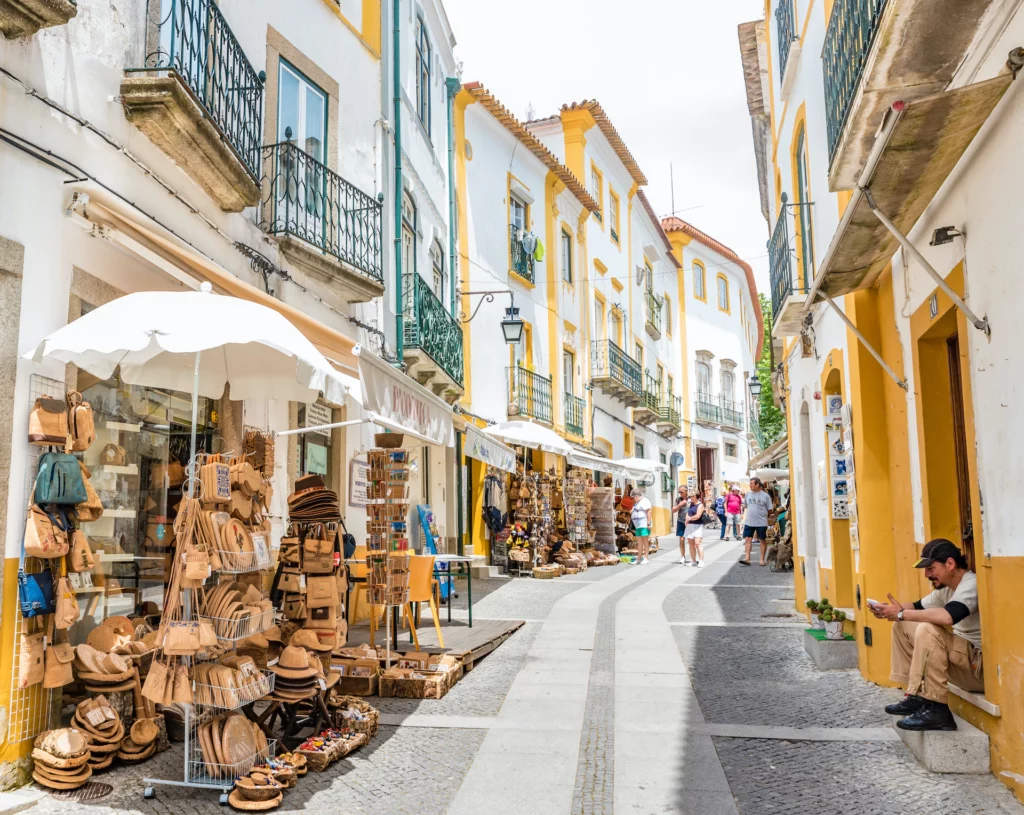
2. Rua Direita, The Main Drag
After entering the gate, you arrive at the gorgeous main drag, Rua Direita. Your head will be spinning right and left to take it all in.
It’s a pedestrianized lane that runs from the Porta da Vila to Óbidos Castle. A stroll down the street is one of the best things to do and see in Obidos.
You may want to start your day in Obidos with some hot chocolate and pastries at an adorable cafe, Pastelaria d’Avo Adelia.
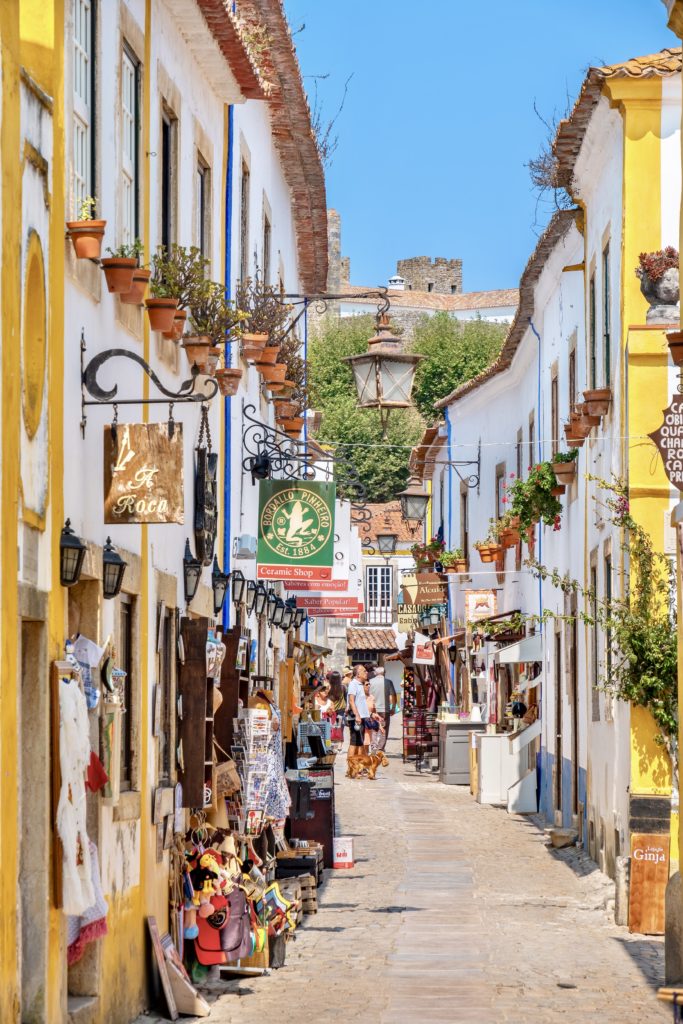
Rue Direita is a cobbled lane dating from the 13th or 14th century.
It’s stuffed with whitewashed buildings, quirky bars and cafes, exquisite shops, and ubiquitous ginjinha stands. The iron street lamps and chipped stone facades complete the vintage look.
I was especially taken with the pottery shops and made several purchases.
These are not your typical tacky souvenir shops. Most of the shops have one of a kind, artisan quality goods.
Be sure to tear yourself away from the lovely ceramics on Rua Direita. It’s Óbidos’ busiest street.
The real magic of Óbidos lies off the main drag.
So veer towards Óbidos’ quiet maze of pathways to enjoy the quiet, color, and romance.
You won’t find another person in sight. This is where you’ll find the intangible fairy dust of Óbidos, and its greatest gift to the traveler.
3. Ginjinha de Óbidos
Ginjinha bars may be on trend in Lisbon, but there’s no escaping them in Óbidos. They’re everywhere. You can’t visit Obidos and not sample it.
Ginjinha is a Portuguese liqueur that’s basically a sour cherry brandy. The one from Óbidos is renowned for its quality and strength.
If you buy Ginjinha from a street vendor, you can have it served up in a plastic cup or in a much more satisfying chocolate cup.
One of the popular stops is to try Ginja right outside the main town gate. They also sell chocolates in a cute wood container, which can be brought home as a souvenir.
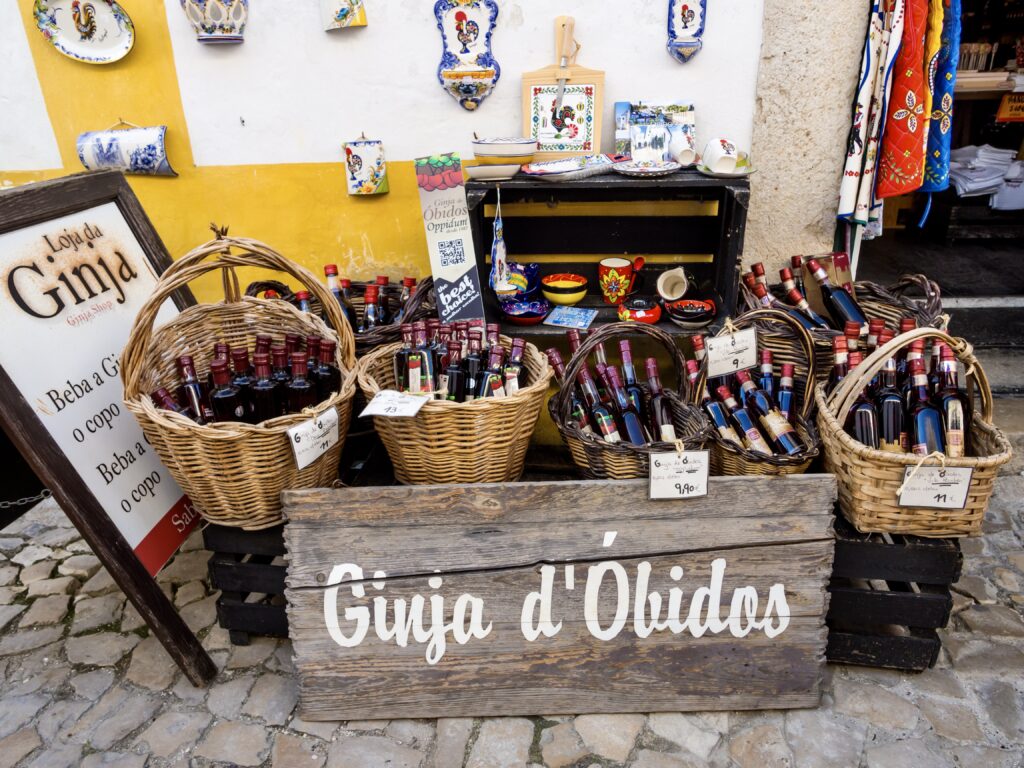
4. Igreja de Santa Maria
You’ll eventually land in Óbidos’ elegant main square, Praça de Santa Maria.
There, you’ll find the austere and imposing Igreja de Santa Maria. The church is free to enter and one of the best things to do and see in Obidos.
The Renaissance church was built in the 12th century. In the mid 15th century, it was the site of a royal wedding.
It’s where the child king King Afonso V (age 10) and his child bride and cousin Isabel I (age 8) were married. Historical records note that a riotous reception took place after the gala event.
The inside is eye catching. There’s a beautifully painted barrel ceiling and altar.
17th century blue and white azulejos blanket the walls. You will also find a 16th century tomb inside. The altar has paintings by thee 17th century artist Josefa of Obidos, who was born in Seville.
In front of the church is a pillory column. It’s a monument to the town’s autonomy and a place where criminals were once punished. Note that the church is closed on Mondays.
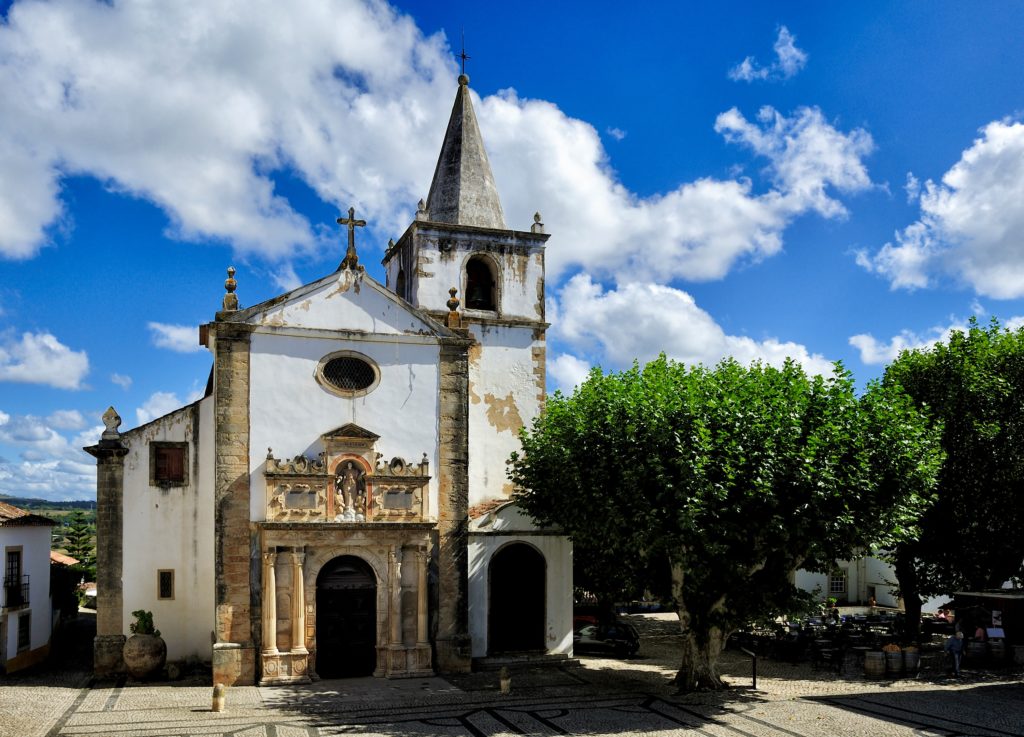
5. Igreja da Misericordia
The street to the right of the main square holds the 16th century Igreja da Misericordia.
It’s worth a quick look just for its blue and yellow azulejo tiles that completely cover the side walls.
You’ll also find 17th century sculptures of the Virgin and a painted ceiling showing the royal crown.
6. Bookstores
Óbidos has been inventing itself as a literally center. Themed bookshops abound.
In 2015, Óbidos held its first literary festival, Folio, which is now an annual event. Óbidos was named the UNESCO City of Literature in 2015.
The former church of São Tiago, St James, has been nattily transformed into a bookshop, the Livraria de Santiago.
The exterior of the building retains the appearance of the original 12th century church. Inside, there’s a colorful altar and the hushed tones make the building bookshop worthy.

Once a 19th century convent, the bookstore that put Óbidos on the literary map is the Literary Man Hotel Bookshop. It’s just off the main drag at Rua D’João d’Ornelas.
It’s the world’s largest literary hotel. It holds over 65,000 secondhand and rare vintage books. There’s a wall of books at every turn.
You can pick anything up off their shelves and check in with reception, if you want to make a purchase.
The bookstore’s open from 8:00 am until midnight. Book nerds can sip a cocktail at the in house gin bar while they get lost in a book.
7. Óbidos Castle
A stroll down Rua Direita eventually leads to Óbidos Castle. It’s one of the seven wonders of Portugal. It’s ancient and forms the northern boundary of the walled town.
The castle was built in 713 during the Moorish occupation. In 1148, during the Reconquista, it was captured by Alfonso I, Portugal’s first king.
In 1210, Alfonso II expanded the castle and gifted it to his wife. It was a favorite spot for royals when they needed a quiet getaway.
The castle witnesses a fair share of joy and misery. In the 13th century, it was the honey moon locale for Dinis and Isabel. In the 14th century, it was for Portugal’s Romeo and Juliet, the star crossed lovers Ines de Castro and Dom Pedro.
In 1755, it was damaged somewhat in the big earthquake that shattered Lisbon. The castle was restored.
Though Óbidos is easily visited as a day trip from Lisbon, there’s plenty to keep you busy. And the hilltop castle isn’t all views. In 1948, it was converted into a luxurious pousada (hotel). It’s one of Portugal’s most historic inns.
The castle retains its medieval decor. The stairs are narrow and steep. There’s no windows, just skinny archer portals.
You’ll get a good night’s sleep because the walls are 3 meters deep, blocking out all light and noise. You can even book a room in one of the castle’s two split level “tower chambers.”
Unfortunately, you can’t go inside the castle unless you’re staying there. But, still, just admiring its crenellated battlements is something.
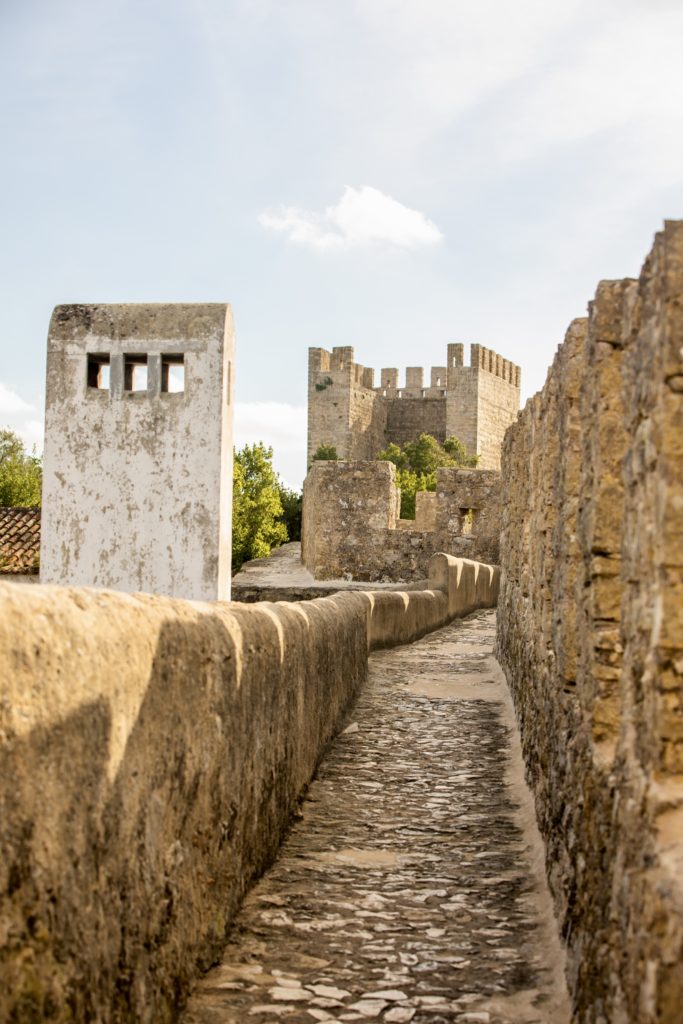
8. Walk The Medieval Walls
You can see Obidos’ city walls as you approach the town. They date from Moorish times, though they’ve been restored over the years.
Walking the walls is definitely one of the best things to do in Obidos. It’s a completely free activity. And, unlike the streets below, they’re not crowed with people.
There are several places to access the walls, from steep stairways to rocky paths. Once you’re on the walls, it’s a narrow path. You may want to walk single file.
It’s only a 1.5 kilometer walk and takes approximately one hour. They’re a bit perilous because there are no handrails.
The castle walls offer some great views of Óbidos and the countryside.
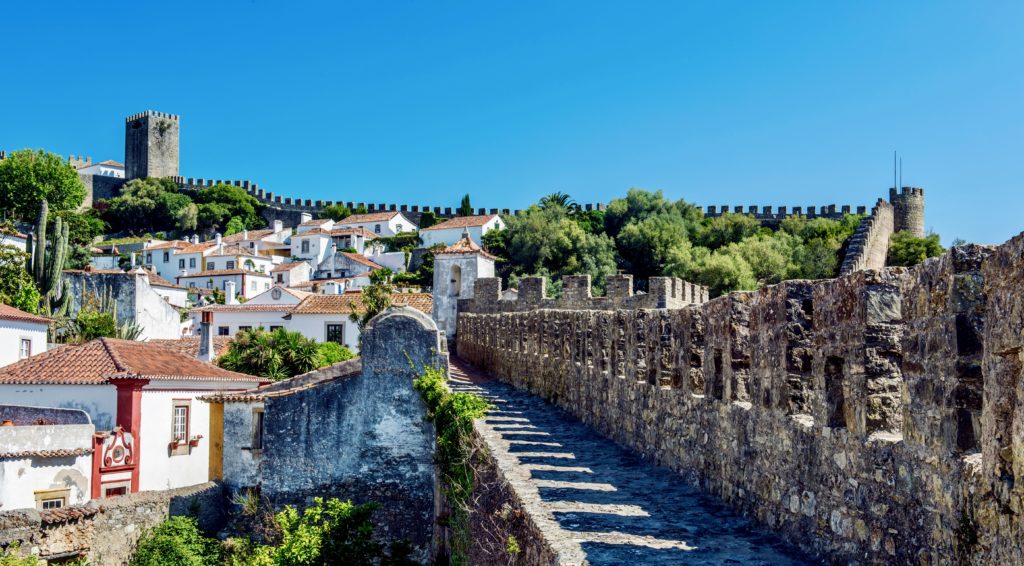
9. Festivals in Óbidos
Óbidos knows how to host a good festival.
Every year, the castle grounds and public squares are taken over by the Chocolate Festival, the Medieval Fair, the Opera Festival, or the Christmas Village.
I was lucky to arrive during the annual Chocolate Festival, which is usually held in April. This is heaven for chocolate lovers.
The narrow streets are filled with stands displaying every conceivable form of chocolate, including huge chocolate sculptures. Top chefs even give cooking demonstrations.
The choices were almost overwhelming. I settled on chocolate covered strawberries.
The Medieval festival is held in July or August. People done medieval costumes and eat and drink 9with goblets) at wooden trestle tables.
10. Santuario do Senhor da Pedra
Below the town and a bit of a stroll is a rather ramshackle abandoned church, the Santuario do Senhor da Pedra.
It’s an 19th century Baroque gem in need of some TLC. It’s unique for its hexagonal interior.
If you want to give yourself a gift, visit medieval Óbidos, the Queen’s Present. It’s one of Portugal’s most otherworldly pretty villages.
Tips For Visiting Óbidos:
1. How To Get To Obidos
By Car:
It’s a 1.5 hour drive from Lisbon to Obidos. If you are driving, don’t bother driving into the old town. There are parking areas just outside the walls, some free and some not. You can’t park inside the town.
By Bus:
From Lisbon, it’s easier to take a bus than a train to Obidos. The RodoTejo Verde (green) bus from Campo Grande station in Lisbon takes just over an hour to arrive in Obidos at Rua da Praca. You can pre-book bus tickets on the Moovit App.
By Guided Tour:
Taking a guided day tour is a great way to explore Obidos as well and makes logistic easier. Most tours combine Obidos with another town.
This full day tour from Lisbon takes you to Obidos, Fatima, and Nazare. This full day tour also includes Batalha.
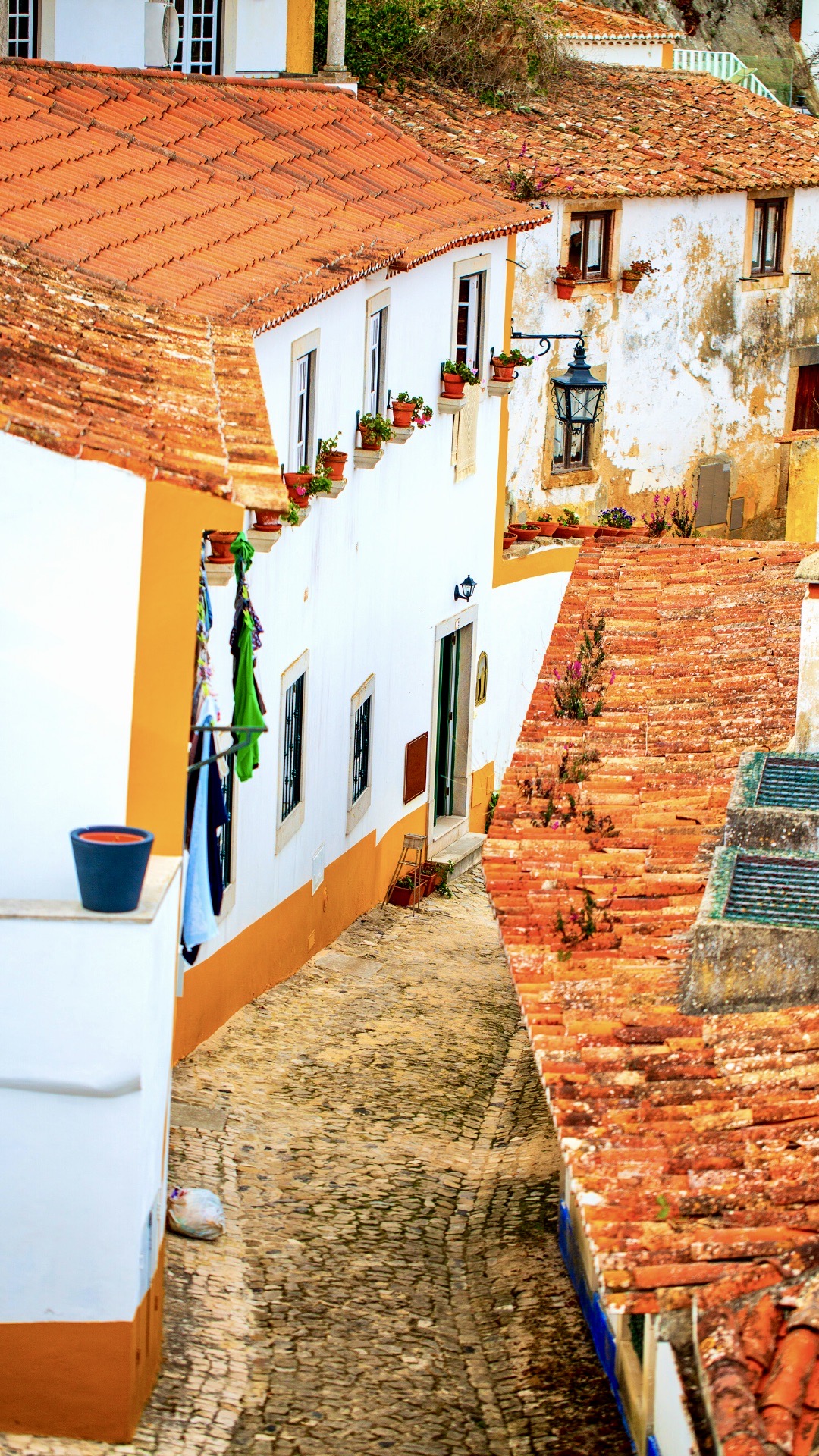
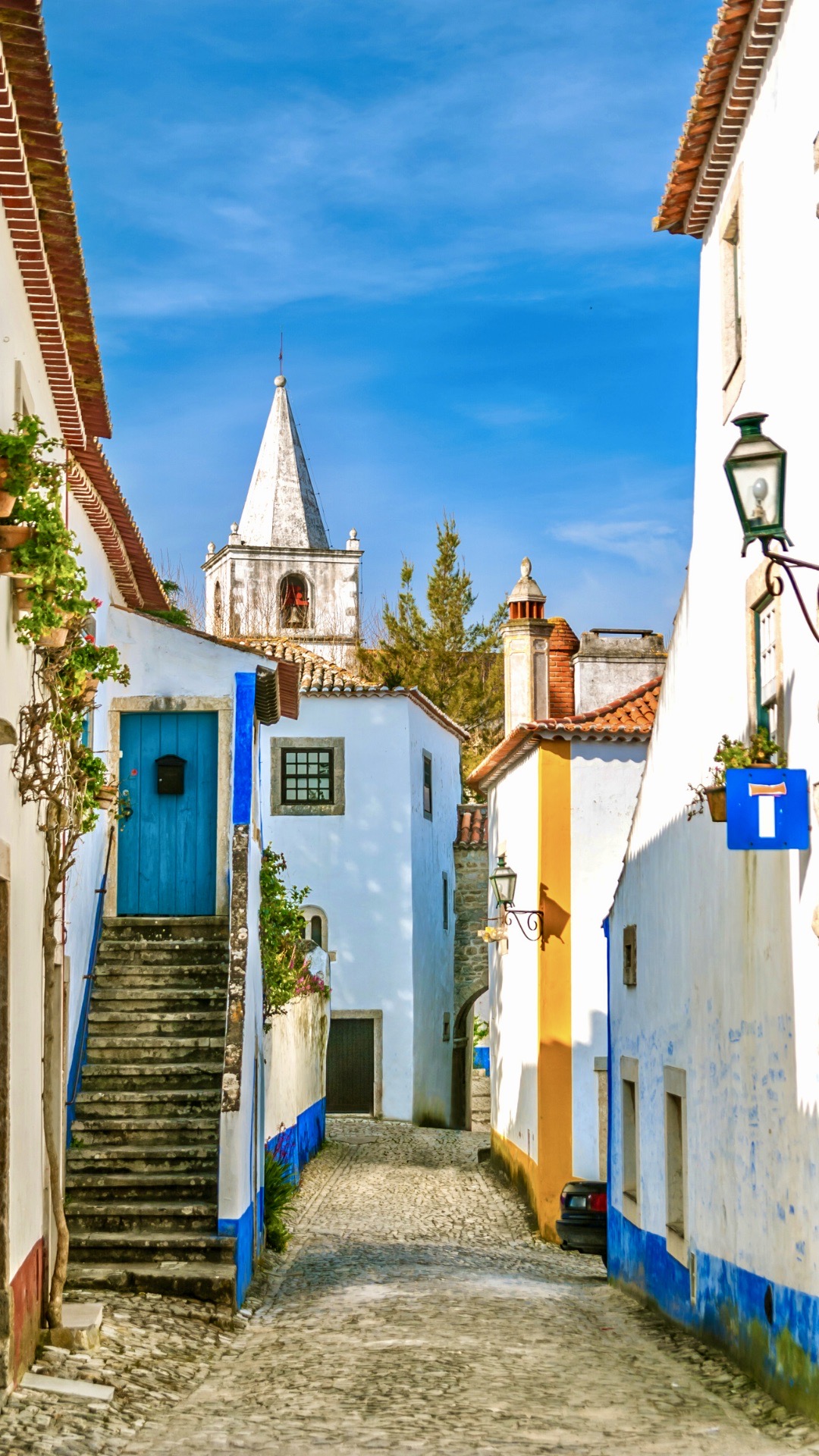
2. How To Get Around Obidos
Obidos is a very small town, so it’s eminently walkable.
And you don’t really have any choice either. Access to the streets are by foot only.
You might consider booking a guided walking tour to get the full scoop on the town’s history and culture.
3. Where To Stay In Obidos
If you decide to stay overnight in Obidos, you are in for a real treat. In the evening, the day trippers are gone and you will have the town to yourself.
Your best choices are Pousada do Castelo de Óbidos and The Literary Man Óbidos Hotel.
I mentioned the castle above, and that’s the most luxurious option. The Literary Man hotel is cool too.
It’s housed in a former convent and has a literary theme. You will find a restaurant, a gin bar, and a wine cellar on the property.

4. Places To Visit Near Obidos
If you are driving to Obidos, or taking a day tour you can definitely add some other attractions or small towns in Portugal. Here are a few places near Obidos that you could also visit.
Nazare
If you want to hit the beach, head to Nazare. It’s about 40 minutes by car from Obidos to Nazare and many guided tours include a stop there.
Nazare is an ancient fishing town and the largest resort town on the Estremadura Coast.
In Nazare, a long sandy beach feeds abruptly at a 360 foot cliff. You can take a funicular to the top. From a lookout point, you can see the resort area.
Batalha Monastery
The Dominican Monastery of Santa Maria de Vitoria is an ornate UNESCO-listed landmark with Gothic and Manueline elements. Building began in 1388 and continued for centuries.
The historic structure was built to celebrate a pivotal 1385 battle, when Portugal overcame the mighty Spaniards in the Battle of Aljubarrota.
The monastery and its church, the symbol of Portugal’s national pride, were built by Portugal’s prolific builder King Joao I, whose tomb is inside.
Characteristic of Gothic-Manueline architecture, you’ll be delighted by the intricate carved floral and marine elements.
The monastery is a must see for lovers of architecture, history, religion, or warfare. You can visit the church for free, but must pay to see the beautiful cloisters.
Alçobaca
Just a little over an hour from Coimbra is the he breathtaking Alçobaca Monastery. If you love history or architecture, the 800 year old Alcobaça Monastery is a must visit destination in Portugal.
The monastery became a UNESCO site in 1989 because of its “size, the purity of its architectural style, the beauty of the materials and the care with which it was built make this a masterpiece of Cistercian Gothic art.”
When you approach the great edifice from the street, you are confronted with an imposing and ornate Baroque facade from 1702.
Once you enter the doors, everything changes. The monastery is actually a monument to simplicity that feels light and airy.
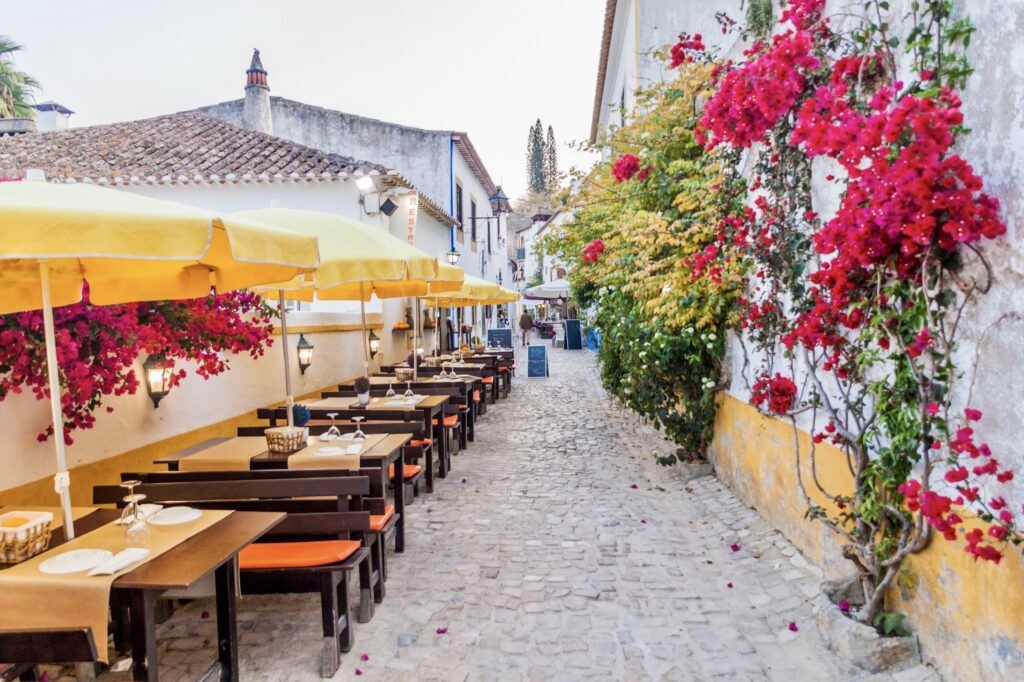
I hope you’ve enjoyed my guide to the best things to do in Obidos. You may enjoy these other Portugal travel guides and resources:
- 10 day itinerary for Portugal
- Historic landmarks in Portugal
- 4 day itinerary for Lisbon
- 2 day itinerary for Lisbon
- 2 days in Porto itinerary
- 1 day in Coimbra itinerary
- Guide to Lisbon’s Alfama neighborhood
- Guide to Lisbon’s Belem neighborhood
- Guide to Pena Palace
- Day trips from Lisbon
- Tips for Visiting Sintra
If you’d like to visit the beautiful town of Obidos Portugal, pin it for later.

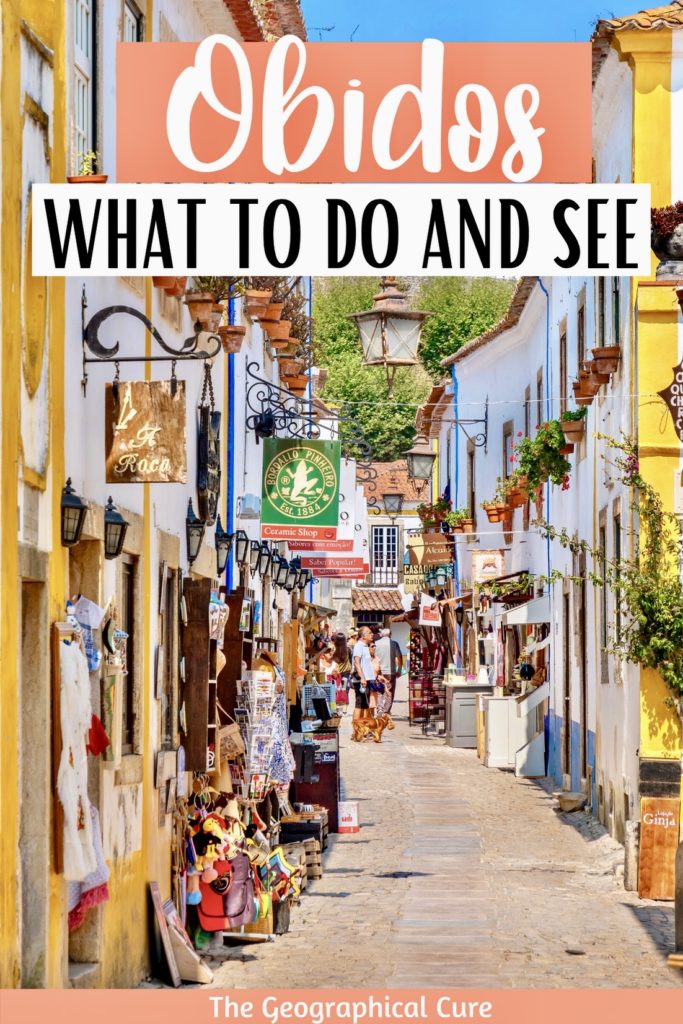
Great overview that I’m going to be using! Just an update – as of summer ’22, you can pre-buy bus tickets using the moovit app.
Thanks for the tip!